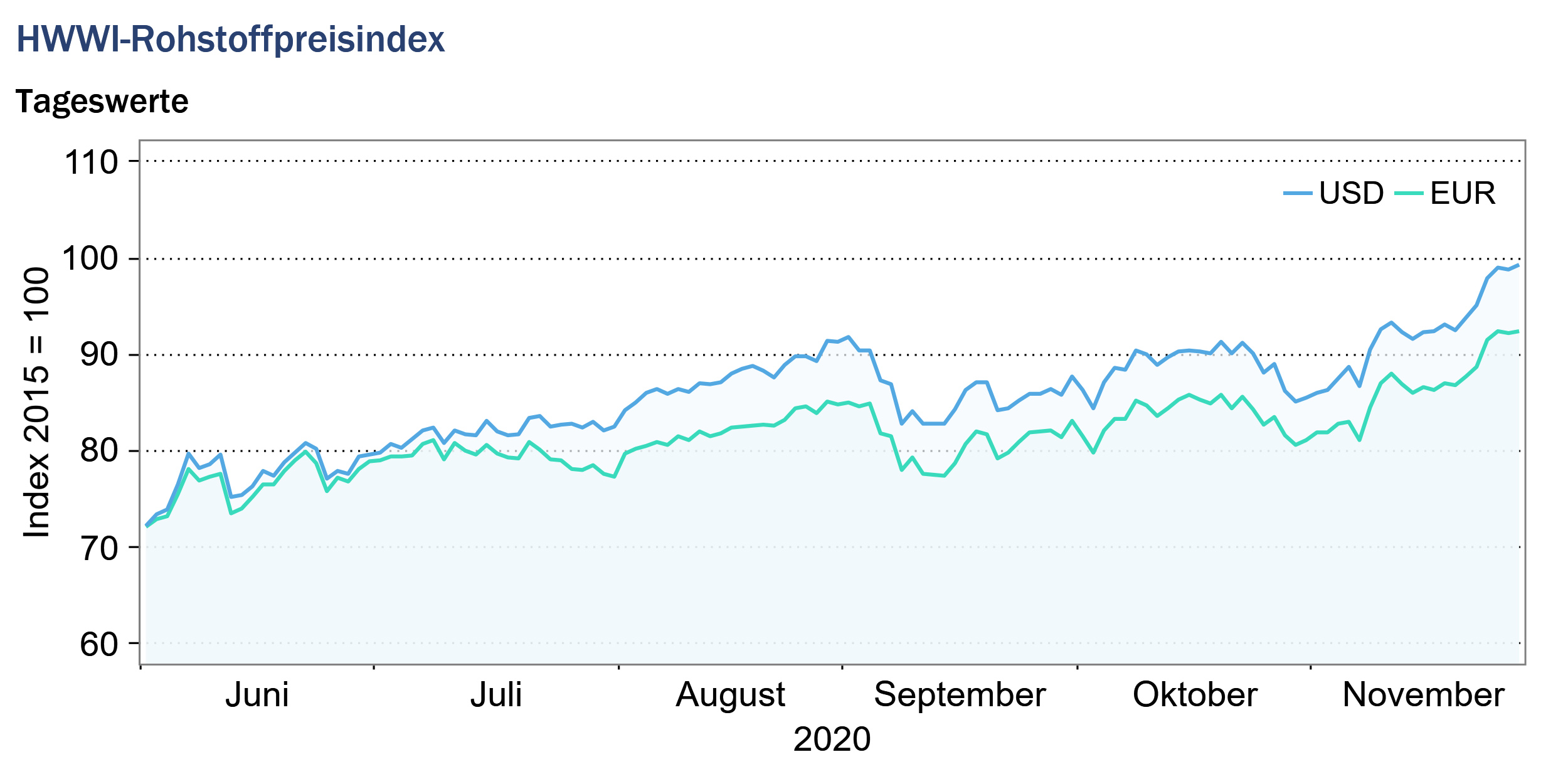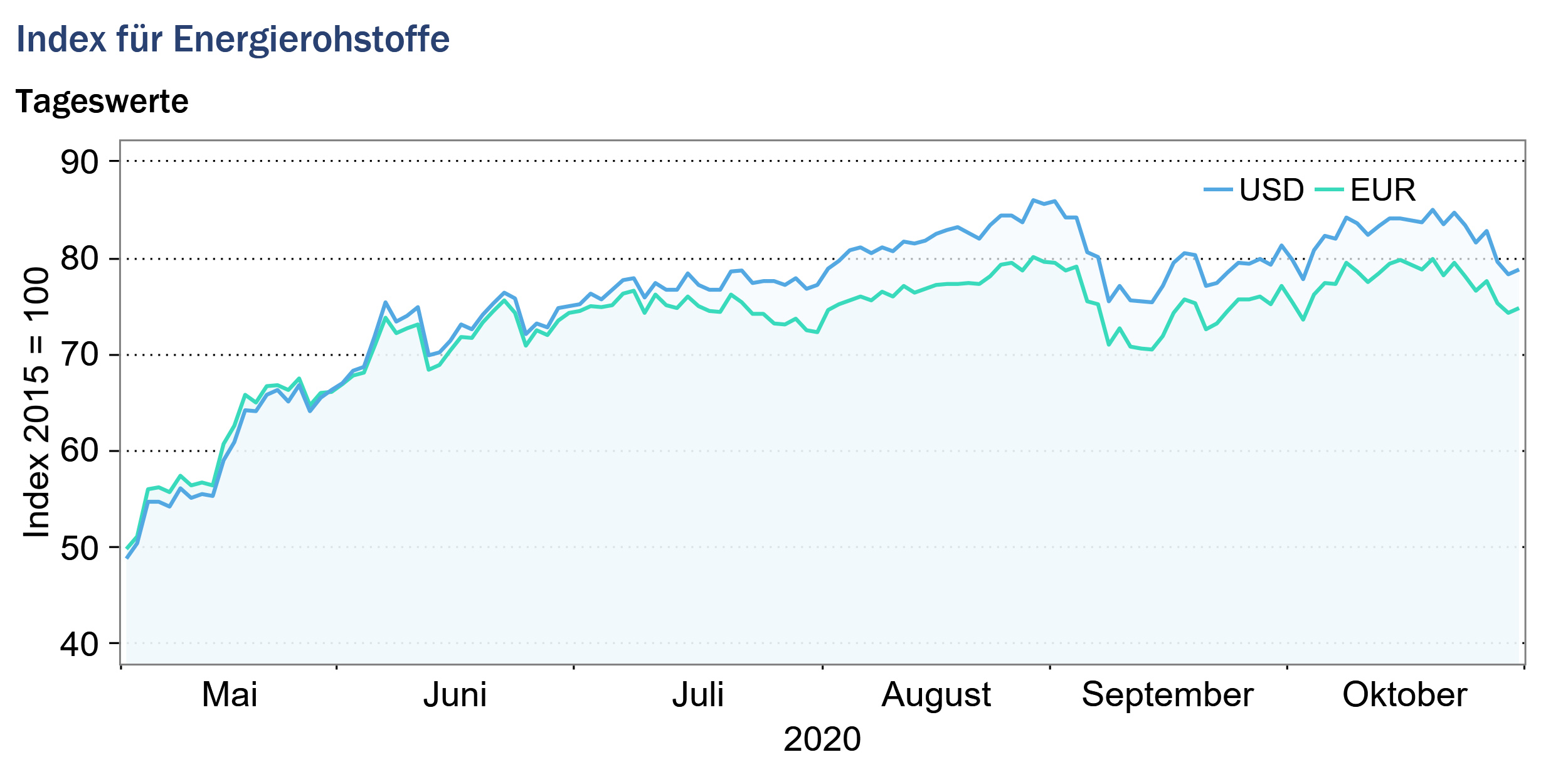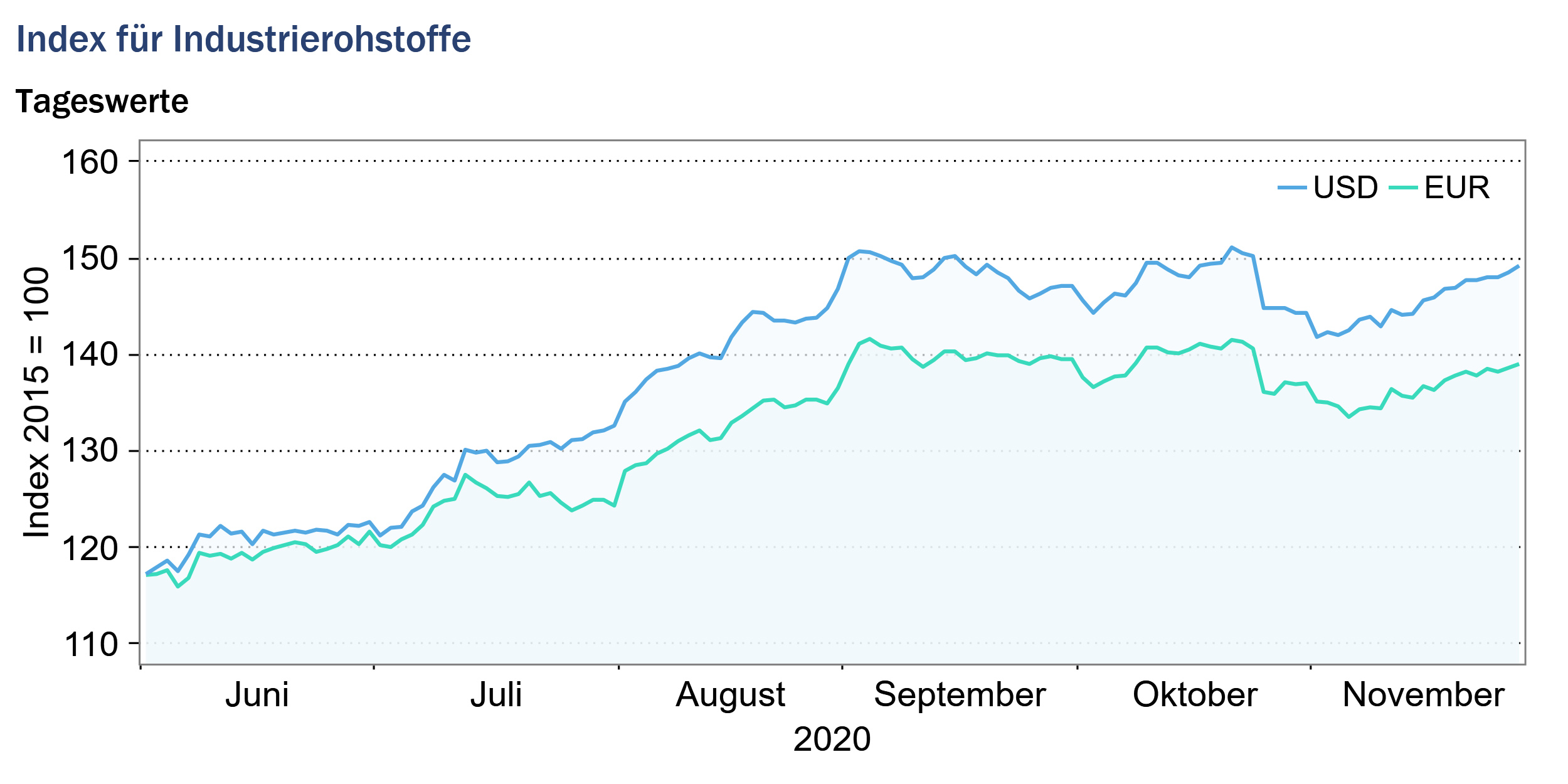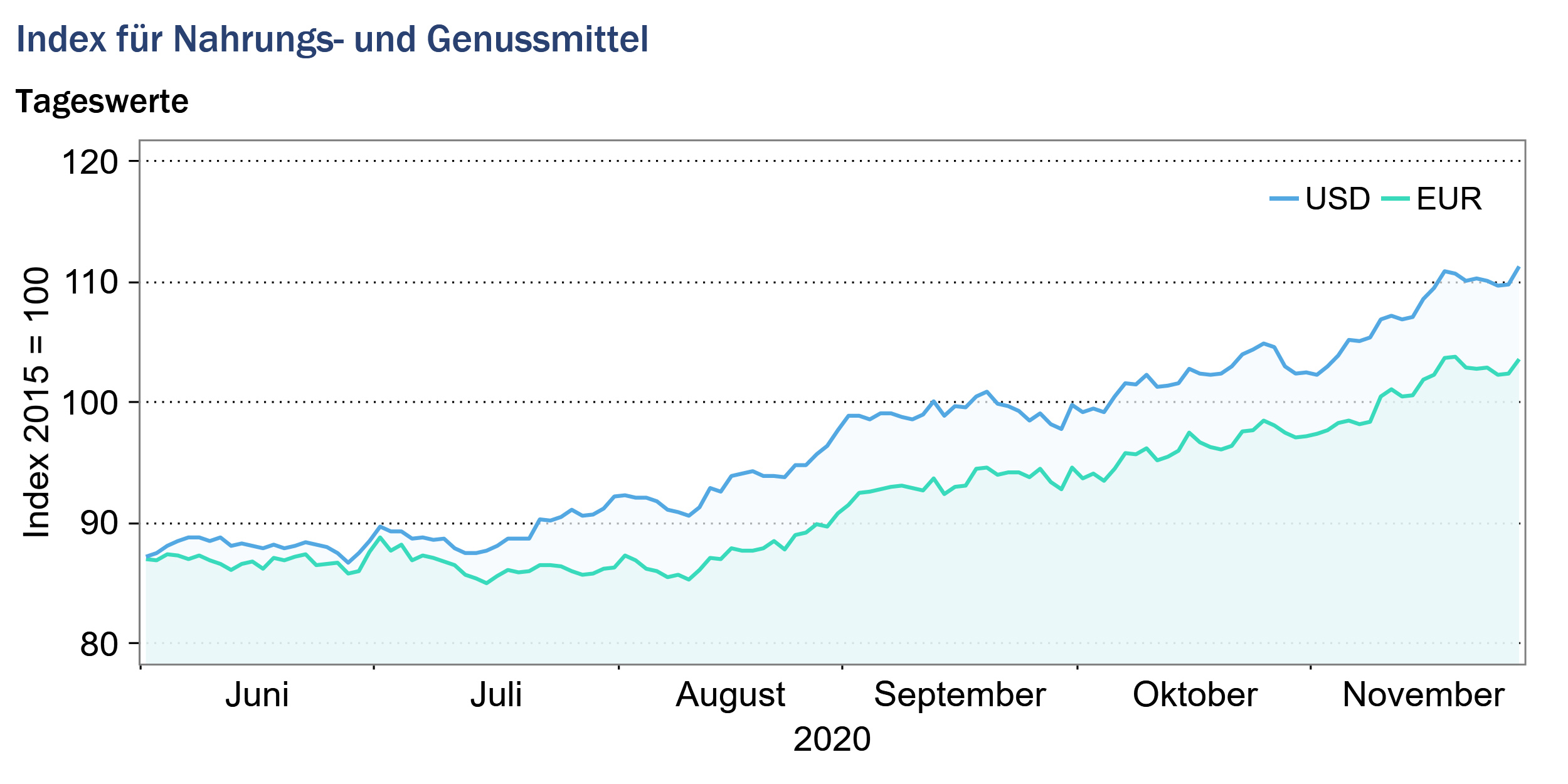HWWI Commodity Price Index Continues to Rise in November
- HWWI overall index increased by 4.7% (US dollar basis)
- Crude oil prices increased 5.9%
- Cereal prices increased by 7%
(Hamburg, December 9, 2020) The HWWI commodity price index increased by an average of 4.7% in November compared to the previous month and is 18% lower than the corresponding monthly value of the previous year. In November, prices on international commodity markets continued to be influenced by the ongoing Corona pandemic. In Europe in particular, infection figures rose and again prompted the introduction of strict lockdown measures in many European countries. However, news of a breakthrough in vaccine development in early November raised hopes that the pandemic would be over and that the global economy would therefore recover. The positive outlook had a particular impact on the crude oil markets in November, driving up crude oil prices. The ongoing positive development of the Chinese economy continued to strengthen demand on the markets for industrial metals and foodstuffs, causing prices to rise in November. Almost all commodities from the various market segments rose on average in November compared with the previous month.

Index of energy commodities: +5.6% (euro basis: +5.0%)
Prices of crude oil grades included in the index rose steadily in November. At the end of the month, for example, prices for the European reference Brent crude were quoted at just under $50 per barrel and prices for the American reference WTI crude exceeded $46 per barrel. The rising price trend on the crude oil markets was driven by the recently announced breakthrough in vaccine research. The prospect of an effective Corona vaccine strengthened hopes that the pandemic would soon be over and that the global economy would thus recover.
On the supply side, the decline in oil reserves in the USA supported the oil price, and market expectations regarding the negotiations of the members of OPEC+ on future production policy, which took place at the end of November, also had a stabilizing effect on prices. The members of OPEC+, including Russia, only reached an agreement in the first week of December after several days of negotiations. To further stabilize oil prices, OPEC+ members plan to increase their oil production by 500,000 barrels per day from January 2021, instead of around two million barrels per day as previously agreed. Due to the current Corona-related uncertainty in the market, OPEC+ also announced that it will review its policy once a month in the new year in order to be able to react as flexibly as possible to price developments.
European natural gas prices continued to rise in November compared with the previous month. Falling temperatures in Europe and increased natural gas consumption in private households due to the continuing output restrictions in many European countries increased the price of European natural gas. Natural gas prices are expected to respond with increases to a greater extent to falling temperatures this year, as many people currently work from home, increasing daily natural gas consumption for home heating. However, U.S. natural gas prices on average rose only slightly in November compared with the previous month.
South African as well as Australian coal prices also showed an average increase in November compared with the previous month. The price of Australian coal rose by an average of just under 9% compared with the previous month, and the price of South African coal even increased by over 14%.
Overall, the energy commodities sub-index rose by 5.6% (euro basis: +5.0%) to 86.9 points (euro basis: 81.4 points).

Index for industrial raw materials: -1.2% (euro basis: -1.7%)
The industrial commodities sub-index is broken down into the agricultural commodities index, the base metals index, and the iron ore and steel scrap index.
Prices for industrial metals continued to be supported in November by strong demand from China, the world’s largest metal consumer. While infection figures continued to rise in the USA and Europe, the Corona pandemic appears to have been overcome in China. The ongoing recovery of the Chinese economy drove prices for zinc, lead, aluminum, and copper further upward in November. The price of copper, which is often used as a barometer for the health of the global economy, rose 5.4% month-on-month, reflecting positive expectations in the markets. The average copper price in November was over 20% higher than in the same month a year earlier. In addition to the positive developments in China, the announcement of the Corona vaccine also had a positive effect on the development of prices for industrial metals.
Australian wool prices also continued to recover in November from the huge price declines of recent months. In November, prices increased by 7.9% compared with the previous month and are still 20% below the average price in November of last year.
Lumber prices, on the other hand, developed in the opposite direction. After a strong price increase in mid-summer, lumber prices recorded a huge loss in November compared to the previous month. However, the average price for lumber in November remained well above the level of the same month a year earlier.
Overall, the index for industrial raw materials fell by an average of 1.2% (euro basis: -1.7%) to 145.6 points (euro basis: 136.5 points) in the month.

Food & Beverages Index: +5.6% (euro basis: +5.0%)
In November, the price increase in the markets for food, beverages and tobacco continued. The three sub-indices for cereals, luxury foods and for oilseeds and oils rose on average in November compared with the previous month.
On the cereal’s markets, a sharp rise in import demand, particularly from China, was met by low supply. The drought phase in South America triggered by the La Niña weather phenomenon and dryness in the harvesting regions of the USA reduced the harvest of corn, soybeans and wheat. Prices for vegetable oils such as soybean oil, coconut oil and palm oil also rose conspicuously sharply in November compared with the previous month, also due to a poor harvest and tight supplies. In addition to unfavorable weather conditions, the poor harvest can also be explained by the effects of the Corona pandemic. For example, due to a labor shortage in the producing countries caused by lockdown measures, fewer oil palms could be planted, and less fertilizer was used due to supply shortages. In addition, global demand for vegetable oils to produce biofuel alternatives is currently on the rise.
After coffee prices fell in October, prices rose on average in November due to supply shortages. Concerns about the ongoing drought in Brazil and damage to coffee plantations caused by hurricanes in Central America drove prices higher in November. Cocoa and sugar prices also recorded upward movements in November compared with the previous month.
The only exception was the price of tea in November. Tea prices decreased on average in November, indicating a decrease in demand. Out-of-home consumption of tea was reduced by contact restrictions to combat the Corona pandemic worldwide.
Overall, the food and beverages index rose +5.6% on average for the month (euro basis: +5.0%) to trade at 107.8 points (euro basis: 101.0 points).

Source: www.hwwi.org
